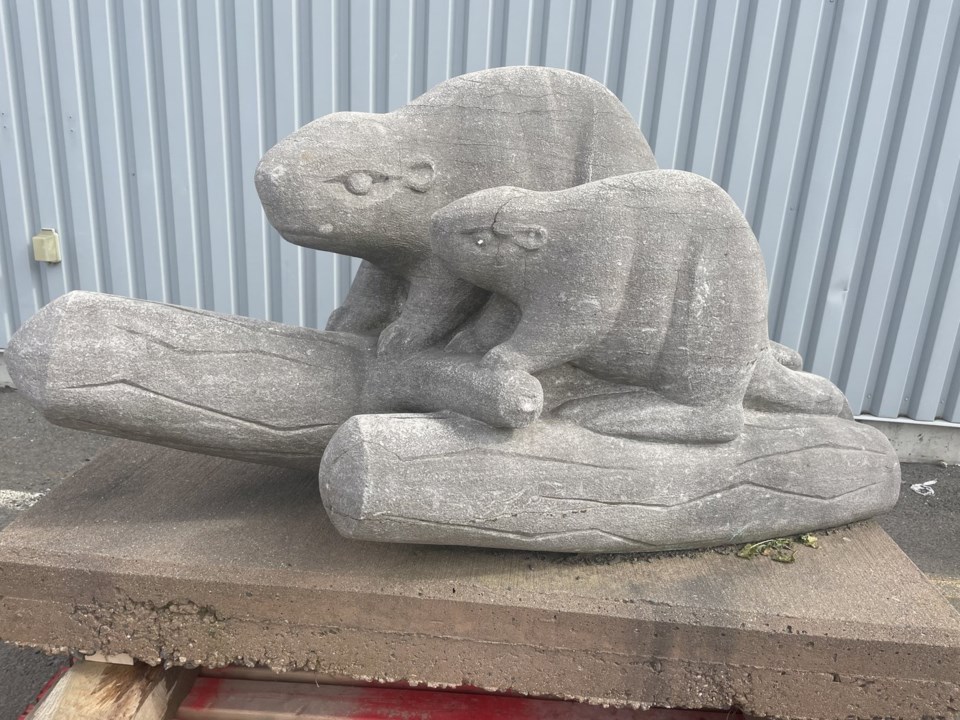FREDERICTON ŌĆö When people pass by the white-pillared Beaverbrook Art Gallery starting this weekend, they will be greeted by one of Fredericton's most famous sculptures.
Called "The Beavers," the artwork is a 1,400-kilogram grey limestone carving of a mother and baby beaver, both hunched over logs. Sitting in the entranceway of the museum, the sculpture is visible from the outside through the building's glass doors. The piece was commissioned by the province in 1959 as a gift to William Maxwell Aitken, known as Lord Beaverbrook, for his 80th birthday.
First installed in OfficersŌĆÖ Square in 1959, the sculpture spent decades braving the elements ŌĆö and generations of children who climbed atop the carving or sat on the beavers' stone backs. But it was removed from the downtown park in 2016 after city workers noticed how badly it was damaged. Following a two-week restoration over the summer, it will be presented to the public in its new home on Saturday.
"I mean, it's just the quintessential Canadian symbol," John Leroux, manager of collections and exhibitions at the Beaverbrook Art Gallery, said in a recent interview. Beavers, he said, are intelligent, and "make things just like Lord Beaverbrook did .... They're very high-functioning animals."
Beaverbrook was from Newcastle, which is now part of Miramichi, and went on to become a newspaper publisher, businessman, politician ŌĆö serving as a British cabinet minister during the two world wars ŌĆö and University of New Brunswick chancellor. He was also a philanthropist, and the Beaverbrook Art Gallery is one of the many projects he funded.
Acadian artist Claude Roussel carved the piece in his basement in Edmundston, Leroux said.
Roussel is considered a pioneer of modern art in Acadia. A recipient of the Order of sa╣·╝╩┤½├Į and the Order of New Brunswick, he founded and became the first director of the visual arts department and art gallery at Universit├® de Moncton in 1963. He has presented more than 200 exhibitions and created 60 sculptures.
Angela Watson, cultural development officer for Fredericton, said the installation of the carving at OfficersŌĆÖ Square in 1959 included a circular wading pool with the animals sitting on the edge of the water.
The wading pool was removed in the early 1990s, and the sculpture sat on a concrete pedestal for the next 30 years, she said, adding that it was a popular and endearing piece on which children climbed or sat.
Leroux said he remembers playing in the wading pool as a kid.
After city workers and officials noticed a few cracks in the sculpture in 2016, Watson said they moved the carving into storage and began exploring how it could be restored. The city hired an art conservator in the summer of 2023 to assess how to preserve it. Watson said the conservator advised officials to clean and restore the beavers, and get the cracks filled in before they got worse.
"She recommended that (the sculpture) be moved inside, because otherwise the cracks would just continue to get larger and larger and (the piece would) eventually crumble."
Cleaning out the lichen and other dirt in the cracks and restoring the sculpture took about two weeks over the summer, and in late fall, the piece was moved to its new home, the Beaverbrook Art Gallery. The city does not yet have the final amount it took to clean and restore the statue, Watson said.
Moving the 1,400-kilogram structure from storage in city hall to the art gallery, about a kilometre away, was the confluence of physics and art. Leroux said movers designed a metal structure on wheels, similar to a bed frame, which had a cradle made of straps that securely held the piece in place as it was moved.
People are still welcome to touch the artwork, he said.
"It was a gift to the public. You're meant to kind of really touch it and engage with it. We're keeping that legacy going."
This report by The Canadian Press was first published Nov. 20, 2024.
Hina Alam, The Canadian Press


